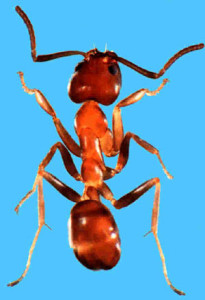 Argentine Ant
Argentine Ant
Argentine Ant, Liniepithema humile Mayr (Hymenoptera: Formicidae)
The Argentine ant, Linepithema humile (Mayr) (Hymenoptera: Formicidae), was introduced into Louisiana in 1890 on coffee ships from Brazil. It has since spread to most of the southern United States where it has become a nuisance pest in the urban environment. It can and does disrupt ecosystems by directly displacing other ant species and other insects. Argentine ants utilize a wide variety of food sources that include protein (live or dead insects) and substances rich in sugars such as honeydew secretions from aphids. Foraging worker ants will also search for food indoors. Argentine ants form large colonies that can include numerous nesting sites that can cover a large area.
Foraging Characteristics: Medium sized ant with a slender body, uniformly light brown or brown. Workers smell stale, greasy, or musty when crushed. Workers often present in large numbers moving in trails. Trails may be similar to white-footed ant trails, but ants are more slender and move more quickly so foraging trails may not appear as condensed. Workers may overwhelm outdoor eating areas, even entering parked cars.
Detailed Description: 2.2-2.6 mm (1/11-1/10 in) long. Twelve-segmented antennae without club. One segmented petiole. Petiole with vertically projecting scale. Body hairs usually absent from thorax. No sting. Subfamily Dolichoderinae.
Most Common Complaint: Many foragers inside and out. Does not normally nest indoors, and can often be excluded from buildings. Spraying outdoors may reduce numbers around buildings, but more may move in from surrounding areas. Baiting may reduce colonies outdoors.
Nest Sites & Characteristics: Multiple queens in many widespread subcolonies that dominate areas with millions of ants. Open habitats, both moist and dry. Usually in heavily disturbed sites but can invade natural environments. Nest in mulch and soil, under objects on soil or near tree roots, in trees, in rotten wood, and garbage piles.
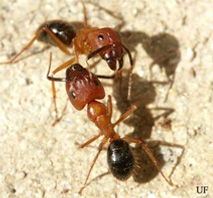 Florida Carpenter Ant
Florida Carpenter Ant
The Florida carpenter ant complex is comprised of several species, two of which are common around structures: Camponotus floridanus (Buckley) and Camponotus tortuganus (Emery). These bicolored arboreal ants are among the largest ants found in Florida, making them apparent as they forage or fly indoors and out.
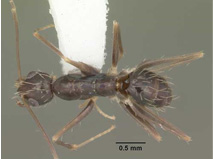 Crazy Ant
Crazy Ant
Over the last few years reports have escalated of a golden-brown to reddish-brown “crazy ant” infesting properties in and around West Palm Beach, Florida. Thick foraging trails with thousands of ants occur along sidewalks, around buildings, and on trees and shrubs. Pest control operators using liquid and/or granular broad-range insecticides appear unable to control this nuisance ant.
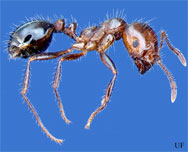 Red Imported Fire Ant
Red Imported Fire Ant
RIFA is native to central South America. It is also established in the U.S. and Australia (Queensland, near Brisbane – as of 2001) (Shattuck and Barnett 2005).
It has been reported in Antiqua and Babuda, Bahamas, the British and U.S. Virgin Inslands, Cayman Islands, Hong Kong, Malaysia, Singapore, Taiwan, Trinidad and Tobago, and the Turks and Caicos Islands (ISSG 2006).
Populations in New Zealand and mainland China are either currently eradicated (N.Z.) or undergoing eradication (China) (ISSG 2006).
In the U.S., RIFA was first introduced from Brazil into either Mobile, Alabama, or Pensacola, Florida, between 1933 and 1945. However, the RIFA infests Puerto Rico, and all or part of many southern and western states from Maryland to southern California (Mobley and Redding 2005).
As of August 2008, the following U.S. states have established infestations: Alabama, Arkansas, California, Florida, Georgia, Louisiana, Maryland, Mississippi, New Mexico, North Carolina, South Carolina, Oklahoma, Tennessee, Texas, and Virginia. The infestations in Maryland and Virginia are sparse and still not formally recognized on USDA maps. Small, localized populations exist in the San Francisco Bay area (David Williams, personal communication, 18 August 2008).
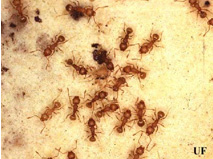 Little Red Fire Ant
Little Red Fire Ant
Prior to the advent of chlorinated hydrocarbons, organophosphates, and carbamates the little fire ant, Wasmannia auropunctata (Roger), was a problem in Florida. The use of persistent pesticide chemicals reduced the populations of the ants until they were no longer a menace. With the reduction in the use of these persistent pesticide chemicals populations of little fire ants have been allowed to increase, and in some areas, to develop into a serious problem.
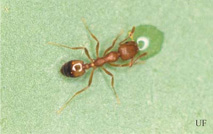 Pharaoh Ant
Pharaoh Ant
The ant, Monomorium pharaonis (Linnaeus), is commonly known as the Pharaoh ant. The name possibly arises from the mistaken tradition that it was one of the plagues of ancient Egypt (Peacock et al. 1950). This ant is distributed worldwide, is one of the more common household ants, and carries the dubious distinction of being the most difficult household ant to control.
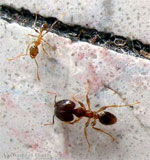 Big Headed Ant
Big Headed Ant
Workers are dimorphic (major and minor workers). The BHA receives its common name from the large-sized head of the major worker, or “soldier.” Minor workers are small (2 mm) reddish brown ants. The majors are much larger (3 to 4 mm), but only constitute about 1% of foragers. The front half of the major’s head is sculptured, while the back half is smooth and shiny. The petiole (waist) of both worker forms is two-segmented and the post-petiolar node is conspicuously swollen. The antenna is twelve-segmented with a three-segmented club. The entire body is covered with sparse, long hairs. Workers have a pair of short propodeal spines (spines on waist) facing almost directly upward. There is usually a dark spot on the underside of the gaster.
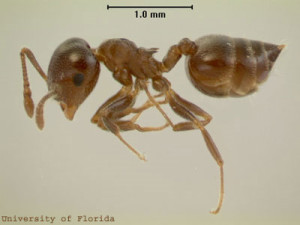 Acrobat Ant
Acrobat Ant
Acrobat ants are small to medium sized ants, generally 2.6 to 3.2 mm long. They have very shiny bodies that are variable in color from light red to brown or black. An acrobat ant’s most distinguishing characteristic is its heart-shaped gaster that is held up over its thorax when disturbed.
Crematogaster ashmeadi has a two-segmented petiole, with the postpetiolar attachment at the dorsal surface of the gaster. The gaster is pointed and equipped with a sting that may or may not be everted (Ferster et al. 2000). There is a pair of short spines on the propodeum, and a few hairs on the head or mesosoma. It is difficult to identify ants to species in the genus Crematogaster, but a new taxonomic key for Florida species is forthcoming (Deyrup, personal communication). C. ashmeadi may be distinguished from other species by its shiny pronotal sides and generally dark color (in live specimens).
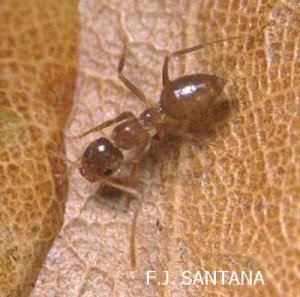 Caribbean Crazy Ant
Caribbean Crazy Ant
Paratrechina pubens is part of a group of ants referred to as “crazy ants” due to their quick and erratic movements. The Caribbean crazy ant is a medium-small (2.6 to 3 mm long), monomorphic, golden-brown to reddish-brown ant. The body surface is smooth and glossy, and covered with dense pubescence (hairs). After feeding, the ant’s gaster (rear portion of the abdomen) will appear to be striped due to stretching of the light-colored membrane connecting segments of the gaster. Antennae have 12 segments with no club. The antennal scape is nearly twice the width of the head. This ant has one petiolar segment and does not sting.
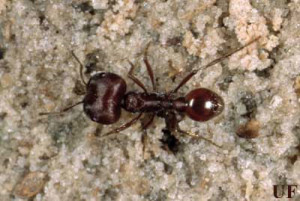 Florida Harvester Ant
Florida Harvester Ant
The adults are dark rust red in color (Haack and Granovsky 1990), with the worker caste strongly polymorphic (1/4 to 3/8 inch long) (Smith and Whitman 1992). The major worker has a disproportionally enlarged head (after Creighton 1950).
Like most other Pogonomyrmex spp. the Florida harvester ant has a psammophore (rows of long hair on ventral side of head) but it is poorly developed (Smith and Whitman 1992). The antennae are clubless with twelve segments. The thoracic dorsum has the sutures obsolescent or absent, and the thorax is not impressed between the masonotum and epinotum; The abdominal pedicel consists of two segments. The tibial spurs on the middle and hind legs are very finely pectinate.
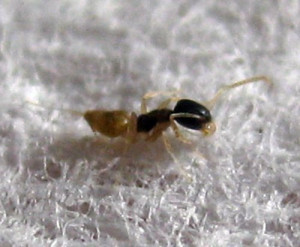 Ghost Ant
Ghost Ant
The ghost ant, Tapinoma melanocephalum (Fabricius), was considered a nuisance ant that was occasionally important as a house pest within Florida as late as 1988. Field populations were confined to South Florida although active colonies had been reported as far north as Gainesville, in Alachua County (Bloomcamp and Bieman, personal communication) and Duval County, (Mattis et al. 2004). But by 1995, if not before, the ghost ant was common in central and southern Florida and had been elevated to major pest status (Klotz et al. 1995). In more northerly states, infestations are confined to greenhouses or other buildings that provide conditions necessary for survival, as the ant is a tropical species either of African or Oriental origin (Wheeler 1910). However, this introduced ant species is so widely distributed by commerce that it is impossible to determine its original home (Smith 1965).Ghost ant workers are extremely small, 1.3 to 1.5 mm long and monomorphic (one-sized). They have 12-segmented antennae with the segments gradually thickening towards the tip. Antennal scapes surpass the occipital border. Head and thorax are a deep dark brown with gaster and legs opaque or milky white (Creighton 1950). The thorax is spineless.
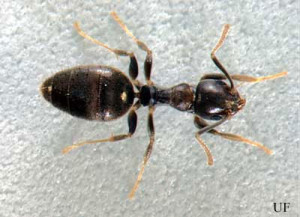 White Footed Ant
White Footed Ant
The white-footed ant, Technomyrmex difficilis (Bolton), has become an important pest ant in Florida. Previously identifed as T. albipes (Fr. Smith), it was correctly indentified in 2007 as T. difficilis (Bolton 2007). Pest control companies, the media and homeowners continually consult universities and government agencies for information on how to control this nuisance ant. This publication provides recent information (as of August 2002) on the distribution and habits of the white-footed ant (WFA) in Florida and the research being conducted on improved control practices.The WFA is a medium small (2.5-3 mm long), black to brownish-black ant with yellowish-white tarsi (feet) and a one-segmented waist. A member of the subfamily Dolichoderinae, WFA have five abdominal segments, 12-segmented antennae, few erect hairs, and no sting.
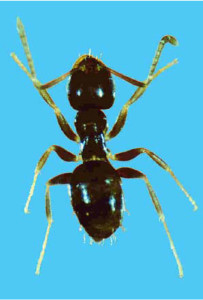 Rover Ant
Rover Ant
Foraging Characteristics: Tiny to small dark brown to pale blond ants. Soft bodied, abdomen covers petiole. May be seen excitedly running up and down vertical objects in yards, such as blades of grass, chairs, and fence posts, accompanied by larger winged individuals. Most often seen as dead, winged alates floating in pools in large numbers; their swollen bodies look striped. Female winged alates are three times larger than workers, males small enough to fit through mosquito screening.
Nest Sites & Characteristics: Under stones in the soil, or in rotting wood.
Detailed Description: 1.5-2 mm (1/16-1/12 in) long. Integument soft. Nine-segmented antennae. One segmentedpetiole, node inclined, usually concealed by base of gaster. No sting. Mesoepinotal impression distinct. Epinotum with short base and very long, sloping declivity. Subfamily Formicinae.
Most Common Complaints: Dead alates floating in pools. Males much smaller than female alates and may not even look like ants because of their size and straight antennae. Males are small enough to penetrate patio screening. Foragers on outdoor furniture and structures. Control for alates not necessary or practical.
Diet: Tend sap-sucking insects to collect honeydew.
 Pyramid Ant
Pyramid Ant
Foraging Characteristics: Medium sized, pale orange to dark brown, slender and elongate ant. Foraging singly, moving quickly. Nest is distinctive cone-shaped mound in sandy soil. Ant does not sting or act aggressively. Nests not large. Workers have strong odor when crushed described by some as rotting coconuts.
Nest Sites & Characteristics: Nest in soil, sandy soil preferred. Typically, nest has a single entrance surrounded by crater-shaped mound of soil and a single queen per nest. One dark colored species, however, is a temporary parasite on the most common orange species and occupies a number of nests at a time, with multiple queens.
Diet: Hunt live insects, including winged fire ants. Collect honeydew from sap-sucking insects.
Detailed Description: 2-4 mm (1/12–1/6 in) long. Integument thin. Twelve-segmented antennae. Propodeum bearing a tooth-like protuberance projecting vertically in side view. Ventral surface of head with a few very long, curved hairs, used for carrying pellets of damp sand. Subfamily Dolichoderinae.
Most Common Complaint: Crater-like nests in open areas of yard. These ants are outdoor species and chemical control is usually unwarranted.
Flight Season: Fall to spring or some species, year-round for others. Warm and humid weather.
Distribution: Widespread
Origin: Native.
The photos and information above were provided by the University of Florida ![]()
